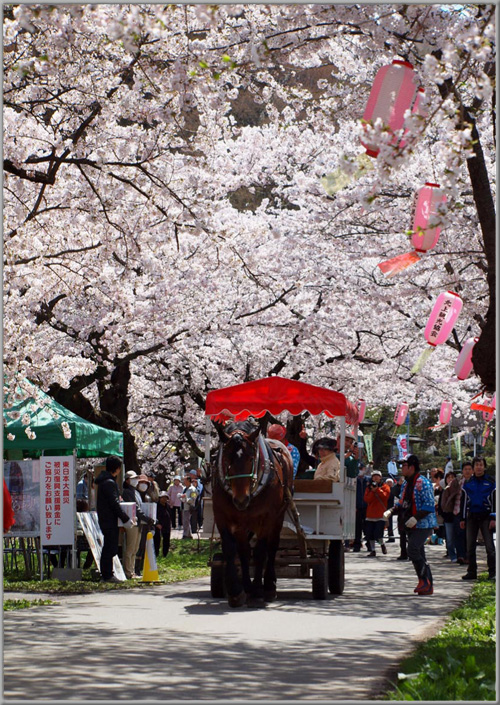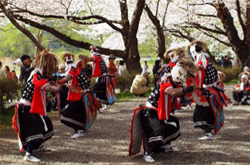Home > Highlighting JAPAN > Highlighting Japan MAY 2011 > Cherry Blossoms Bring Cheer
Highlighting JAPAN
COVER STORY: The Road to Recovery
Caption: A horse pulls tourists in a carriage through the tunnel of cherry blossoms at Tenshochi,
Iwate Prefecture. At left, people collect donations for victims of the Great East Japan Earthquake.
Credit: TADASHI AIZAWA
Cherry Blossoms Bring Cheer

Onikenbai dancers perform in support of the victims of the Great East Japan Earthquake.
Credit: TADASHI AIZAWA
From April 15 to May 5, a festival celebrating the cherries' blossoming took place under the name of "Gambaro Iwate! Kitakami Tenshochi no Sakura" (Let's do our best, Iwate! Cherry blossoms of Tenshochi in Kitakami). The inland district suffered minor damage from the Great East Japan Earthquake, and there was no damage to the park. This year, the ninetieth anniversary of the inauguration of the park, was no different from past years in the sense that the first cherry blossoms in the park were observed around mid-April and the cherry trees were in full bloom at the end of April. Between the rows of cherry trees in bloom, which extend about two kilometers along the Kitakamigawa river, viewers feel as if they are in a tunnel of cherry blossoms. Sightseeing horse carts travel slowly through the tunnel.
According to a representative of the Kitakami Sightseeing Association, the organizing body of the event, "Just after the devastating earthquake, we decided to organize the festival with the aspiration of encouraging people in the afflicted area. It attracted around 140,000 visitors. This figure is about a quarter of the level reached in normal years, but both locals and visitors were happy that the festival was held. The Kitakami City Government chartered a bus and invited people living in the hard-hit coastal region of Iwate Prefecture to Tenshochi in the hope that they would feel relaxed at the sight of the cherry blossoms."
Commented a man in his thirties who came from Waga-gun, Iwate Prefecture with his wife, two daughters, and parents, "The damage we suffered from the earthquake was limited. It just caused a crack to the groundwork of our house. However, we have some relatives who are more seriously affected. We send them supplies to cheer them up. Next year, we will invite them to Kitakami to see the cherry blossoms."
On April 29, an event called Onikenbai took place at Tenshochi, in memory of those killed in the disaster. It is a local traditional dance that is said to have a history of more than 1,300 years. Each dancer wears an oni (devil) mask, holds a sword in one hand and dances dynamically by swinging in every direction to the rhythm of a drum and a gong, and to the music played by flute. The event involved about 180 dancers. After their performance, they each held out a donation box and asked tourists for contributions.
© 2009 Cabinet Office, Government of Japan






